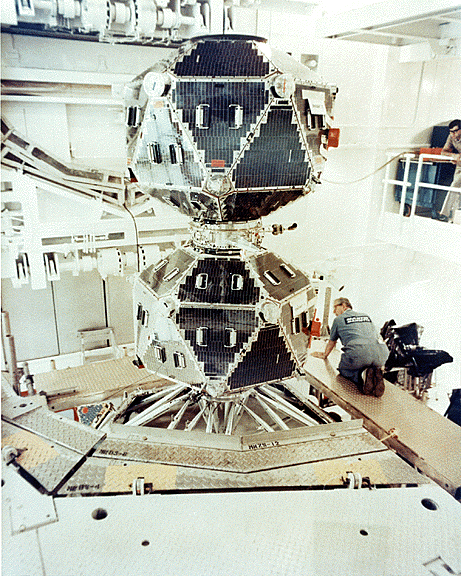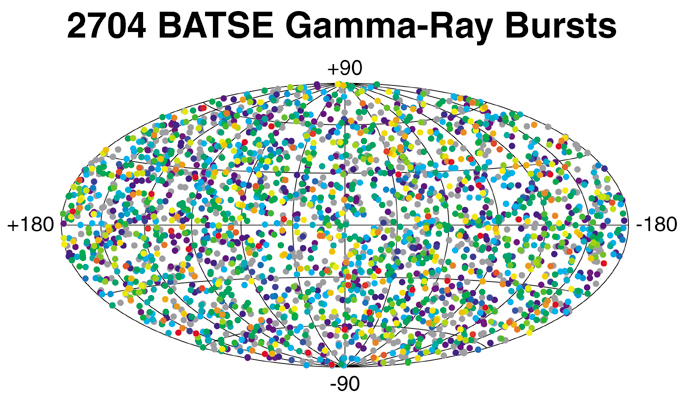Back to School with GRB 101
- By Barb Mattson
- October 30, 2015
- Comments Off on Back to School with GRB 101
Up until a few years ago, gamma-ray bursts (or GRBs, for short) were arguably the biggest mystery in high-energy astronomy. Basically, gamma-ray bursts are brief, extremely bright bursts of gamma-rays (as the name implies). They appeared at random across the sky. But what are they? What causes that burst? And what can we learn from them?
I find it hard to talk about gamma-ray bursts without going into the history, because it’s such a recently solved mystery. The mystery is so recent that I had a professor in grad school who mused that watching gamma-ray burst scientists was a bit like watching 6-year-olds play soccer. Just as the 6-year-olds run in a clump following the ball from one side of the field to another, the scientists would follow each new piece of evidence, which took them in a new direction.
I’ll keep the history to a minimum, but you can read more on the Swift education site. Gamma-ray bursts were first discovered by the Vela satellites in the late 1960s. The primary job of the Vela satellites was to monitor the sky for gamma rays from Earth, which would be evidence of a nation testing nuclear weapons. The satellites started seeing bursts of gamma-rays, but they were instantly recognizable as coming from beyond Earth. Since those events weren’t Vela’s primary mission, the data for those bursts results sat in someone’s desk drawer for years until he had time to look back at them.

The Vela 5 satellites in the cleanroom. These were the first satellites to detect gamma-ray bursts. Image courtesy of Los Alamos National Laboratory.
The biggest challenge of studying GRBs is that the burst of gamma-rays lasts for only a few seconds up to a couple minutes before disappearing completely. Early on, it was difficult to tell exactly where in the sky they were. In part, because they happened so quickly, but also because we needed better gamma-ray detectors. Before there was a single gamma-ray detector that could localize a GRB, astronomers used a variety of detectors with poor localization, but widely separated. Doing that, they could triangulate positions. The more detectors, the better they could localize the GRB.
The next challenge was figuring out where the GRBs originated. Were they part of our galaxy? Or did they come from much further away? These were very bright bursts for a very short amount of time — putting out more energy than our entire sun will emit in its lifetime, but in just a few seconds! And at first, scientists couldn’t image that these powerful explosions could be from outside our galaxy. Such a bright burst would have to be come from extraordinary explosions to be seen that far away.

GRBs appear randomly across the sky as this all-sky map of the locations of over 2700 bursts detected by the BATSE instrument aboard the Compton Gamma Ray Observatory shows. Credit: NASA
In 1997 when a satellite called BeppoSAX detected the first X-ray “afterglow” from a gamma-ray burst. Afterglow is emission that lingers after the initial burst of gamma-rays. For the first time, astronomers were able to study a burst site after the GRB faded AND, even better, they could take a spectrum of the X-ray emission to find the distance. It turns out GRBs are distant. Very distant. Gamma-ray bursts are one of the most distant things we can detect.
Since then, gamma-ray burst observations have focused on seeing the afterglow as soon as possible. It can be seen in X-ray, optical, ultraviolet, and radio wavelengths. Based on these observations, it started to become clear that most GRBs are associated with supernova explosions. Not all supernove explosions create GRBs, and understanding the conditions that create a GRB are part of current research.

In the most common type of gamma-ray burst, illustrated here, a dying massive star forms a black hole (left), which drives a particle jet into space. Light across the spectrum arises from hot gas near the black hole, collisions within the jet, and from the jet’s interaction with its surroundings. Click for full size! Credit: NASA
Our division at Goddard has two of the premiere satellites that are currently used for the study of GRBs – Swift and Fermi – so Blueshift has talked about GRBs a few times in the past.
- Blueshift interviewed the Principal Investigator of the Swift mission on the occasion of its 10th anniversary
- Blueshift talks about the other type of gamma-ray burst in their Awesomeness Round-up from April 11, 2011
- Listen to the podcast “We’re Back” to learn more about how Fermi studies GRBs
- Listen to the podcast “Life and Death” to hear about how Swift helped solve the mystery of GRBs


